“You’re the only person I know who comes to Mojokerto to see its ancient ruins.”
Monica expressed her amusement over dinner at a modest, dimly-lit local restaurant in the East Javan city. I knew her from college and this was only the second time we met after we both graduated – the first was a coincidence as we spotted each other at Kuala Lumpur’s old Low Cost Carrier Terminal (LCCT) six or seven years ago. Despite its compact size – with a total area of less than 17 square kilometers – Mojokerto and the neighboring regency of the same name form one of the most important industrial centers in East Java province, hosting the production facility of one of Indonesia’s largest paper manufacturers as well as that of a Japanese food and chemical company known for its MSG-related products, among other big names.
The ancient sites of Trowulan, a district about 13 km to the southwest of Mojokerto, have been on top of my wish list for quite some time. As the former capital of Majapahit, the last major Hindu kingdom based in the island of Java, Trowulan is home to ancient ruins and structures which are rather unusual for Java: they were mostly built using red bricks as opposed to the dark volcanic stones found aplenty in other parts of the island. The abundance of the latter was pivotal for the construction of hundreds of ancient temples across Java, including the eighth-century Mahayana Buddhist masterpiece of Borobudur and the ninth-century tall and slender shrines of Prambanan, both erected during the period of the Medang kingdom; the 12th-century Penataran which is today East Java’s largest ancient temple compound; and the highly-ornate Kidal and Jago built by the rulers of the 13th-century Singhasari kingdom.
Majapahit was founded in the late 13th century by Raden Wijaya who successfully defeated the invading Mongol army in Java. The first monarch of the new kingdom ruled for 16 years until the ascension of Jayanegara – Raden Wijaya’s son – to the throne. Under the reign of its second ruler, Majapahit saw the outbreak of several rebellions, weakening the central authority of the kingdom. Exacerbated by Jayanegara’s unpopularity partly thanks to his penchant for taking the wives and daughters of his subordinates as his own, in 1328 the king was murdered by the court’s healer. Jayanegara died without having any sons to claim the throne, and therefore the next in line to become Majapahit’s ruler was Raden Wijaya’s first wife. However, as she decided to become a bhikkhuni (female Buddhist monk) her daughter Dyah Gitarja was appointed to become the kingdom’s next ruler, taking the title Tribhuwana Wijayatunggadewi (or Tribhuwannotunggadewi Jayawishnuwardhani).
Under the rule of the kingdom’s first female monarch, with the loyal support of her ambitious prime minister Gajah Mada, Majapahit’s importance in the region grew and its area expanded with a series of conquests like that of neighboring Bali in the mid-14th century. It was under her rule that Gajah Mada took his famous oath – called the Palapa Oath – to abstain from spices (or other earthly pleasures) until he managed to bring the many regions of the surrounding archipelago under Majapahit’s control. After a 22-year reign, Queen Tribhuwana abdicated following the death of her mother and she was replaced by her own son, Hayam Wuruk. It was under the fourth monarch’s rule when Gajah Mada finally fulfilled his oath, spreading Majapahit’s political and cultural influence to places far beyond its core realm, including what is now peninsular Malaysia and the southern Philippines. The nature of this influence, however, has been the subject of debate among scholars and historians with some believing that Majapahit was a thalassocracy, while others argue that relations between the Java-based power with other kingdoms in the region were that of an equal partnership with a common interest in maintaining peace and security in the waters of Maritime Southeast Asia.
Regardless of which argument is true, Majapahit’s past wealth and grandeur are palpable at its former capital in what is now the district of Trowulan. Past excavations revealed the ancient canals of a city covering a total area of 9 x 11 square kilometers and unearthed ruins of settlements, an indication of the large population that once resided here. The ancient sites of Trowulan are in fact the only surviving capital of any ancient kingdom in Indonesia, although much of its structures have been forever lost – local residents recycling the ancient bricks and using them to build houses, as well as the damage caused by plantations and industrial facilities are the main culprits.
But not all is lost. Standing just off the main road connecting Mojokerto and Trowulan is Wringin Lawang, an ancient entryway built in the split gate style – known as candi bentar – which is still prevalent today in places like Bali and some cities in Java. Typically located at the outermost gate of an important complex, the twin red-brick gate now stands in solitude, separated from the din of traffic only by rows of local residents’ houses. Closer to the central compound of the purported location of the main palace of Majapahit is Bajangratu, another gate built in a different architectural style which is in fact the most ornately-decorated surviving ancient structure in Trowulan. No written documents have been found regarding the construction of both Wringin Lawang and Bajangratu, leaving Old Javanese texts like the Negarakretagama and Pararaton as the main source of information on the history of Majapahit. While the former is a eulogy written under Hayam Wuruk’s rule in the 14th century, the latter is a chronicle created between the 15th and 16th centuries. According to an interpretation of Pararaton, Bajangratu was dedicated to the second ruler of Majapahit who died in 1328. In addition to that, the presence of dragon-like bas-reliefs on the towering roof of Bajangratu also suggests that this structure was constructed around the 14th century, a period when the Yuan dynasty – one of Majapahit’s main trading partners – still controlled China.
For a more comprehensive look at Majapahit’s artistic and cultural achievements, James and I visited Museum Trowulan. Housing a multitude of richly-embellished artworks as well as regular house appliances made of stone, metal and clay dating back to the Majapahit period that occupy two chambers at the front section, the museum offers visitors a glimpse into the daily life of the former capital’s residents. Directly behind the main building, an open-air pavilion is the resting place for some of the most important statues and sculpted artifacts discovered in East Java, including those created centuries prior to the rise of Majapahit.
After walking around the pavilion and being astonished by the beauty conceived by highly-skilled artisans hundreds of years ago, I gazed upon a group of white tents to the south of the pavilion which looked deserted. We came closer and found ruins of brick structures shaded from the harsh sun which was even more scorching at the height of the dry season. Ironically, the modern structures which were built to protect the centuries-old remains of the Majapahit-era settlements underneath seemed to have already given in to the elements; their elevated viewing platforms were severely corroded, as were the access stairs, deeming them unsafe to climb. Around lunchtime we left the museum and headed back to Mojokerto, with my mind still perplexed by the state of preservation of Trowulan’s ancient sites.

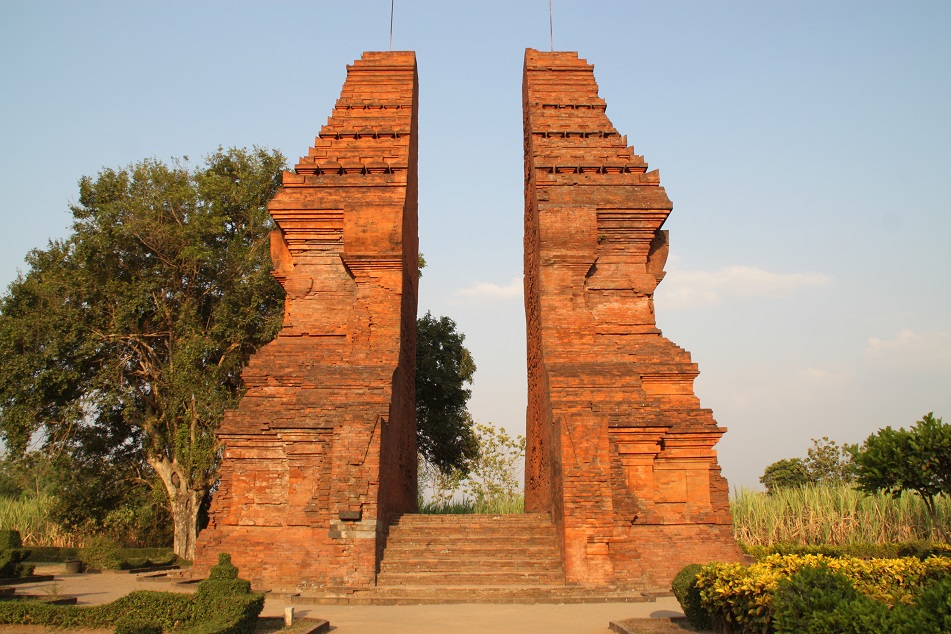






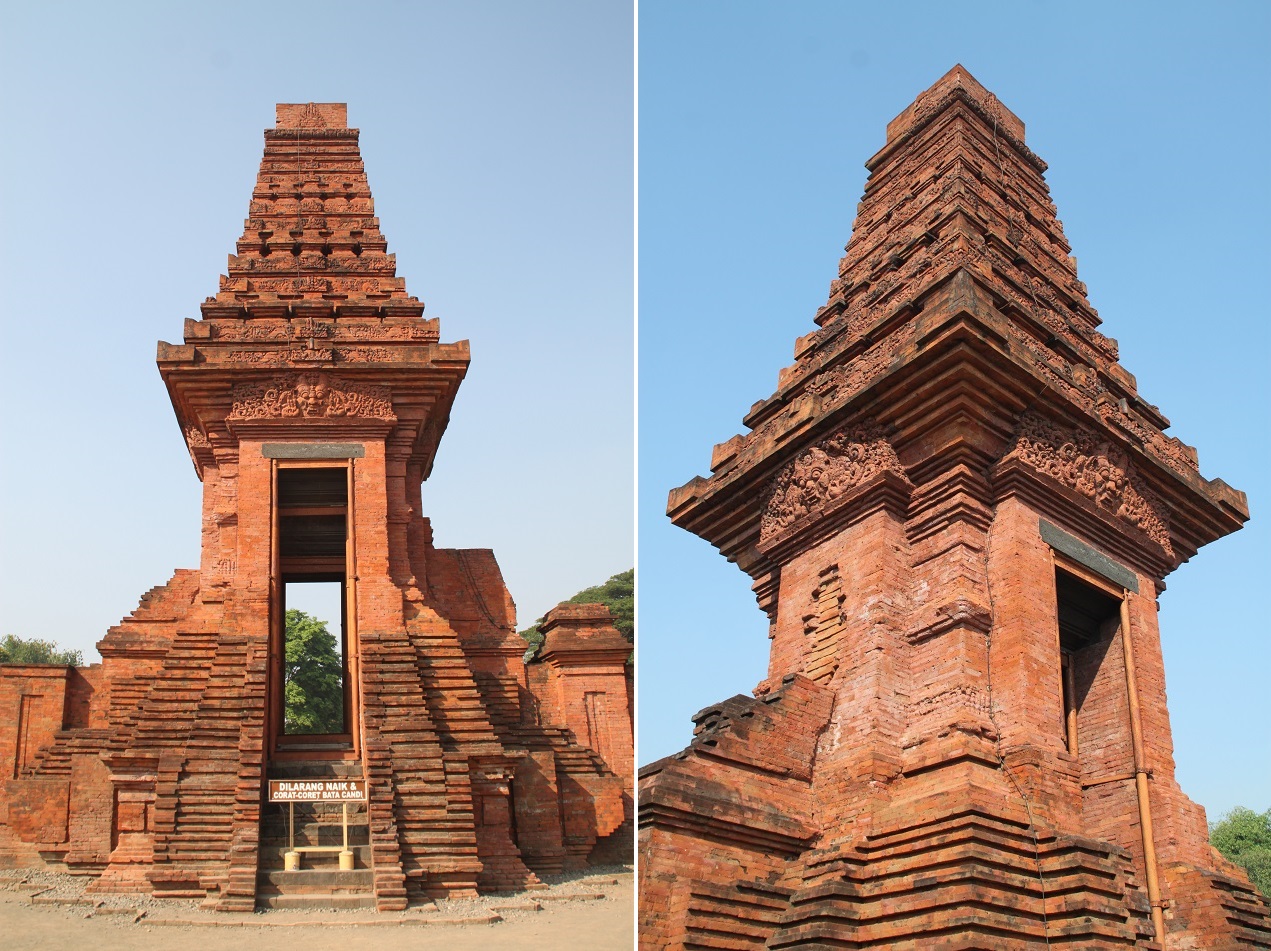



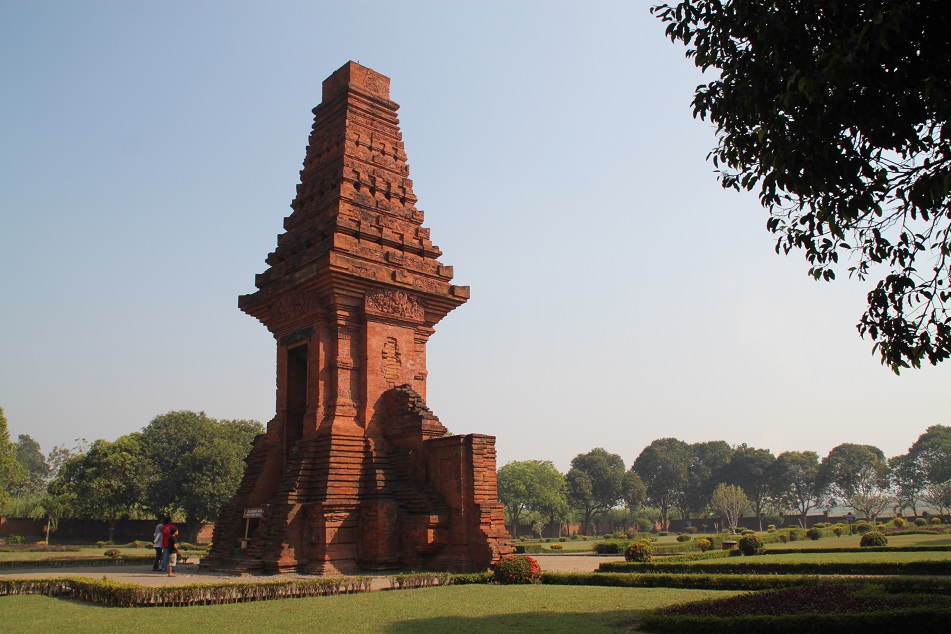
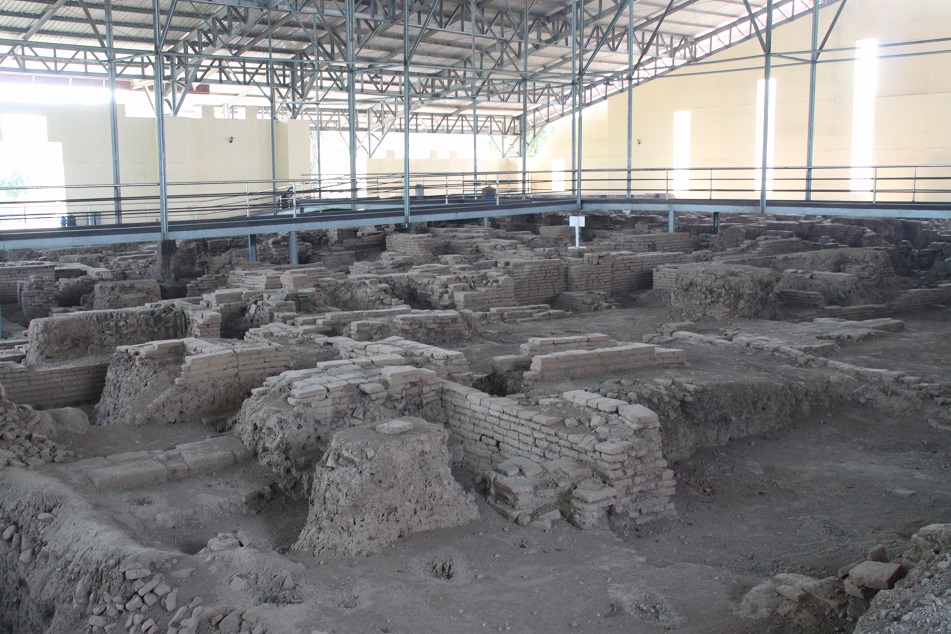





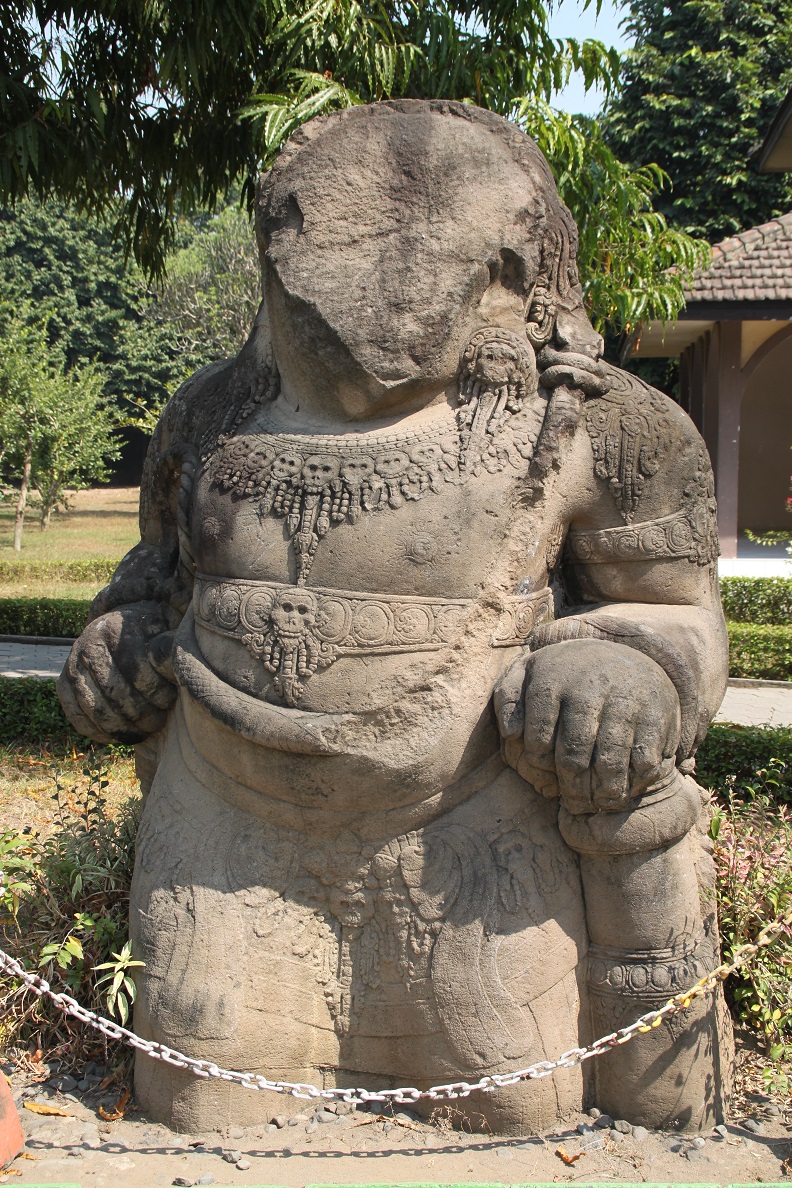
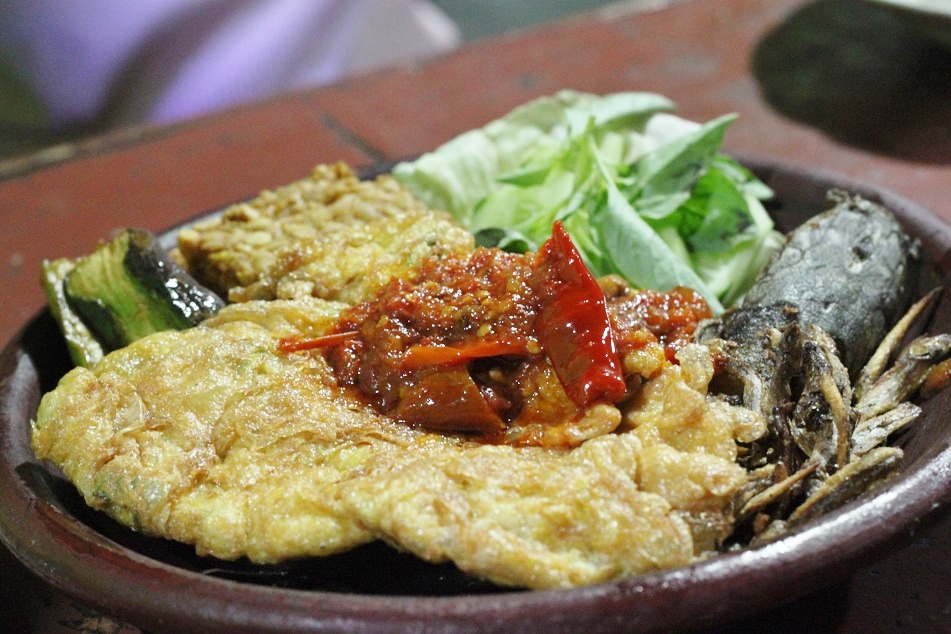
Wow! Beautiful, scholarly and entertaining! What’s not to love? Reblogging to sister site “Timeless Wisdoms”
LikeLike
Much appreciated, Ana! And thanks for the reblog.
LikeLike
😊
LikeLike
Pingback: Trowulan: An Ancient Javanese City – Timeless Wisdoms
Model2 bangunan seperti ini jawa timur banget..
LikeLike
Candi-candi di Jawa Timur memang punya gaya arsitektur yang khas. Ada sebagian kecil candi, seperti Candi Badut di Malang, yang gayanya lebih mirip candi di Jawa Tengah, menandakan umur dari candi tersebut yang lebih tua dibandingkan candi-candi yang dibangun di masa Singasari atau Majapahit.
LikeLike
Fascinating history lesson on the ancient Javanese city of Majapahit! Great photos, Bama, as always!
LikeLike
Thank you, Peter! If only more structures were preserved from the kingdom’s ancient capital, Trowulan would have been an even more magical place.
LikeLiked by 1 person
What fabulous photos of this amazing place.
Alison
LikeLike
Thanks Alison. It was well worth the journey all the way from Jakarta.
LikeLiked by 1 person
The red brick immediately caught my eye as being different from what I’d seen at other temples on Java. Thanks for the explanation. The warm colour and elegant shape are striking. I can’t recall seeing the maja fruit before, and that lotus photo is spectacular!
LikeLike
Ancient red brick structures are easier to find in Sumatra, but not in Java. That’s why the sites in Trowulan are very unique. However, based on my observation ancient temples made with volcanic stones tend to stand the elements much better than their red brick counterparts. Thanks for reading, Caroline.
LikeLike
You captured it well! Great and interesting post, as usual!
LikeLike
Thanks John & Susan. I hope one day life will bring you to this part of the world. 🙂
LikeLike
That dwarpala looks menacing with its garland of skulls. Thanks for a post on a place which is new to me.
LikeLike
The carvings on the dwarapala were influenced by the school of Tantrayana which, if I’m not mistaken, was quite influential during that period of time in the history of Indonesia. Glad you enjoyed this post!
LikeLiked by 1 person
I had to smile at the opening quotation; you really do find history and ancient ruins everywhere, Bama! Like others, I was intrigued by the red bricks and would say I like their warmth and glow even better than the darker structures better known on Java. Particularly pretty photos overall today – my favorite is the maja fruit!
LikeLike
I follow quite a few Instagram accounts focusing on ancient ruins across Indonesia and Southeast Asia. I don’t know why I’m so interested in this kind of sites, particularly the fine carvings that usually adorned such structures. If I were super rich I think I would have built one for modern-day sculptors to channel their talent and for others to enjoy. Thanks for the kind words, Lex! That maja fruit is said to be bitter though (pahit means bitter in Indonesian).
LikeLiked by 1 person
Keeping part of the ruins undercover was something I first saw in Malta. I felt cheated, but suppose it’s the best way to preserve ancient sites. Another fascinating find!
LikeLike
I felt the same when I saw the Buddhas of Polonnaruwa in Sri Lanka. All the images I saw prior to my first visit showed those gigantic statues in beautiful morning light with clear blue skies at the background. But when I went there I found a massive canopy over them. I learned that it was installed to protect this ancient site, which is of course more important than my wish to get good photos.
LikeLiked by 1 person
Saya orang jawa timur, sampai sekarang belum pernah ke sini. Sedih.
Memang betul, meski sudah dimasukkan ke dalam daftar wisata, sepertinya Mojokerto masih belum dilirik. Saya mengamini kalimat dari teman Mas Bama. Meski sekarang sudah lebih banyak yang berkunjung sepertinya.
LikeLike
Halo Mas Gallant. Jangan sedih mas, memang dari pengalaman dan pengamatan saya kita cenderung lebih cepat mengeksplor tempat-tempat yang lebih jauh dari rumah dibandingkan dengan tempat-tempat yang ada di ‘pekarangan’ sendiri. Teman saya yang di Mojokerto itu bahkan baru pertama kali berkunjung ke Trowulan beberapa tahun yang lalu! Saya sendiri sudah tinggal di Jakarta 10 tahun masih belum menyempatkan diri berkunjung ke Candi Jiwa dan Candi Blandongan yang sebenarnya cuma sepelemparan batu dari Jakarta.
LikeLiked by 1 person
Wringin Lawang, with that perfect gap between the two brick structures, is so damn modern that it could be Bauhaus. Awesome.
LikeLike
Wait until you see the photos I took of another ancient structure in Trowulan which to me looked rather modernist than Javanese or Hindu/Buddhist. I’ll write about it on an upcoming post.
LikeLiked by 1 person
Looking forward to that!
LikeLike
It definitely looks like Bali. I like the red brick – it glows in the sunlight. Pretty incredible, as you say, that these are standing after hundreds of years and the things we make today barely last at all.
LikeLike
When Islam’s dominance grew on Java, many Majapahit royals fled to Bali, bringing along the finest artisans of the kingdom. That’s why one will see the resemblance between Balinese and Javanese architecture styles.
LikeLike
Ah, I’m a sucker for ancient ruins as well. Your entryway gates remind me of Shelley’s words: “And on the pedestal these words appear:/’My name is Ozymandias, king of kings;/Look on my works,/ye Mighty, and despair!’/Nothing beside remains.”
LikeLike
We in Indonesia don’t really learn about Shelley, although I did hear about Ozymandias somewhere. So I had to google it up, and wow! He was part of a small circle of people who did competition on writing sonnets. Now I can see your reference.
LikeLiked by 1 person
🙂 Ah, the wonders of Google. Since it’s poetry season for me, I want to know: what poets do you learn about in Indonesia?
LikeLike
I mostly learned about Indonesian poets at school, although there were also mentions about those from India, Persia, and the Middle East. Shakespeare is the only European poet I remember learning when I was a kid.
LikeLiked by 1 person
What an amazing place Bama. So much history!
LikeLike
So many amazing, yet lesser known, places on the island of Java alone, Nicole. And I’m on a mission to visit them, one place at a time.
LikeLiked by 1 person
Going to Trowulan made for a very memorable long weekend – and it was such a wonderful change of pace from our daily routines in Jakarta. Thank you for bringing these Majapahit-era ruins to my attention, Bama! It just amazes me how much ancient heritage there is on Java alone, and how many more Hindu-Buddhist temple sites we still have yet to visit.
LikeLike
Even East Java alone has so many ancient temples; out of probably a dozen such sites in Blitar we’ve only been to two, and on our short trip to Malang we managed to go to five of them. At the moment I’m eyeing Candi Jabung in Probolinggo, Candi Ngawen in Magelang, and Candi Jago in Jogja, although the ones closer to Jakarta shouldn’t be missed either. I don’t think I’ll ever get templed out! 🙂
LikeLike
What a beautiful structure. Thank you for the lesson of history, Bama.
South-East Asia has so many ancient places. Unfortunately, by this moment, I was managed to visit only Cambodia with its Angkor Complex.
LikeLike
And thanks for reading, Victor. Angkor surely is among the most impressive ancient sites in Southeast Asia. Next time you visit this part of the world you might be interested in visiting Borobudur and Prambanan in Indonesia, Bagan in Myanmar, and My Son in Vietnam. Those are among the easiest sites to visit.
LikeLiked by 1 person
Thanks a lot, Bama.
LikeLiked by 1 person
Terimakasih buat tambahan perbendaharaan kata barunya Bam. Talasokrasi.
Btw, aku suka dengan foto pertama yang menjadi pembuka tulisan ini. Entah dirimu sengaja atau nggak, di situ ada orang melintas di antara Wringin Lawang. Dengan itu aku jadi bisa membayangkan skala bangunannya. Dan itu di luar bayanganku. Karena sebelumnya aku membayangkan gerbang satu ini gak terlalu besar ukurannya. Ya sebelas dua belas dengan gerbang di area masjid Sunan Kudus lah. Ternyata cukup besar juga ya.
Dan foto-foto detail sisa bangunan yang masih dalam tahap penggalian itu memperlihatkan kalau pada jaman tersebut bangsa kita sudah mempunya teknik pembuatan bangunan yang cukup baik. Lantai-lantai heksagonal nya mirip dengan conblock jaman sekarang. Materialnya batu atau apa Bam?
LikeLike
Sama-sama Bart. Orang itu sebenernya datang beberapa lama setelah aku ada di sana sih. Pas dia naik tangga yang ada di gapura langsung tak foto aja, dan tujuannya memang untuk kasih lihat perspektif karena tadinya pun aku pikir Wringin Lawang gak sebesar ini. Gapura Bajangratu aja tadinya aku pikir ukurannya kayak candi-candi di Gedong Songo, tapi ternyata cukup besar dan tinggi.
Yang menarik dari lantai heksagonal itu memang ternyata ratusan tahun yang lalu bentuk ini sudah dipakai, jadi bukan kreasi modern. Materialnya sendiri kayaknya sih batu, tapi aku gak terlalu yakin juga sih. Bayangkan berapa banyak hasil temuan manusia yang kembali terkubur bersama hilang/punahnya suatu peradaban, sehingga manusia yang hidup jauh setelahnya harus mengalami proses penemuan yang sama lagi. Salah satu contoh yang paling aku inget tentang ini adalah mekanisme Antikythera.
LikeLiked by 1 person
Benar juga ya Bam. Bisa jadi ada banyak hal di dunia modern ini, yang sebenarnya bukan barang baru lagi, karena pernah ada di masa terdahulu. Malah terkadang aku pikir ya, ada banyak hal yang kita lihat dari hasil karya jaman dulu yang sampai sekarang kita masih bingung, bagaimana dulu mereka membuat/membangunnya. Dan sebenarnya hal-hal itu hanya sedang menunggu untuk kembali ditemukan dan diungkap oleh kita di masa sekarang.
Ngomong-ngomong itu buah Maja sengaja ditanam di situ ya? Bisa diicipin gak sih? Aku sampai sekarang masih berpikir kalau buah itu cuma kiasan saja. Semacam representasi dari kenikmatan duniawi gitu.
LikeLike
Betul banget. Makanya buatku mengunjungi tempat-tempat kuno dan berkunjung ke museum sudah jadi hal wajib di setiap trip. Soal buah maja yang ada di dekat candi-candi di Trowulan mungkin sebagian memang tumbuh alami, tapi sebagian lagi bisa jadi memang sengaja ditanam. Harus tanya penjaga tiap lokasi sih kayaknya. Setauku yang merepresentasikan kenikmatan duniawi itu buah palapa, yang berdasarkan beberapa referensi yang aku baca ternyata merujuk ke buah pala. Kalau maja setauku memang aslinya pahit.
LikeLiked by 1 person
Eh iya, palapa. Duh. Khan sumpahnya palapa, aku kok malah salah fokus jadinya. Kalau buah maja khan diadopsi untuk nama kerajaannya. Maafkeun …
LikeLike
Tak sampaiken permohonan maafnya ke Patih Gajah Mada.. 😀
LikeLiked by 1 person
Terimakasih raden 😀
LikeLike
Jadi ingat pelajaran sejarah di jaman SD – SMA dulu 😀
Bangunan utamanya masih berdiri kokoh dan gagah ya.
Yang bikin keliatan cakep itu detail bangunannya.
Gak kebayang di jaman dulu bisa membangun bangunan yang detailnya bagus banget.
Semoga suatu saat bisa kesini 😀
LikeLike
Setiap kali saya mengunjungi candi-candi pikiran saya juga membayangkan hal yang sama. Hebat banget ya orang dulu bisa membuat bangunan megah dan indah dengan ukiran relief yang halus. Kalau bangunan serupa dibangun di masa sekarang sepertinya akan makan biaya yang sangat besar. Untungnya seni ukir masih dilestarikan di beberapa daerah di Indonesia sampai saat ini, dan jujur saya punya impian sebetulnya bahwa suatu saat nanti di Indonesia akan dibangun suatu bangunan megah yang dihiasi dengan berbagai seni khas Indonesia dan bisa dinikmati semua kalangan. 🙂
LikeLike
Clear explanation, as always Bama. It reminds me of history lessons from high school that I took decades ago. Something that makes me a bit sad is when I read how the population caused the damage for one of the most important of historical heritages in our nation. Meanwhile, in other countries, they did whatever they could to preserve their ancient sites. I hope in the future, our people will have more awareness to protect and appreciate the ancient ruins.
LikeLike
Thank you, Nurul. Education is key; when those people realize the value of preserving such ancient sites, and when they’re actively involved in their preservation, their sense of belonging to those invaluable heritage structures will eventually grow. It’s everyone’s task to make this happen.
LikeLiked by 1 person
It doesn’t surprise me at all to hear: “You’re the only person I know who comes to Mojokerto to see its ancient ruins.” Bama, you have a way of sniffing out and finding hidden gems wherever you travel and this is another example. The photos show diversity between the incredible ruins and nature, and then to read of the history of the place. Amazing to hear about something so glorious in the past, be almost unheard of today. The history of SE Asia never, ever, ceases to amaze and thanks to people like you who give it the treatment it deserves 🙂
LikeLike
I once wrote that finding me at ancient sites is easier than doing that in malls. 🙂 What’s intriguing about Trowulan is the fact that it used to be a very wealthy city with sophisticated canal network, dotted with exquisite gates and temples. In an upcoming post I will show how hundreds of years ago people came up with an architectural style which wouldn’t look out of place today. Thanks for reading, Randall.
LikeLike
Remarkable discovery, Bama. How ornate the carvings of these ancient structures. I especially appreciate how they were built to frame the sky and its objects. Also very mush impressed with the hexagonal slabs placed on the ruins floors… how did they cut that with such accuracy? This world we live it… wow, it never ceases to amaze me!
LikeLike
I first learned about Trowulan more than two decades ago but it wasn’t until last month I finally got the chance to go there, and it really didn’t disappoint. It is indeed amazing to think of the accuracy and finesse ancient artisans put into their work, something that is hard to replicate even by modern-day sculptors.
LikeLiked by 1 person
Pingback: Trowulan: Beauty in Red Brick | What an Amazing World!
Thank You for this great post and its gorgeous photos.
Happy and safe travels!
LikeLiked by 1 person
And thank you for reading! This is a lesser-known part of Java and it’s worth visiting only if you have ample time on the island.
LikeLiked by 1 person
Lesser known as my unknown Helsinki. 😁
LikeLiked by 1 person
Helsinki is quite well-known, at least here in Indonesia because that’s where the peace agreement between the Indonesian government and the Aceh separatist movement was signed. But for me, it’s the architecture, sauna culture, and northern lights that make me want to go to Finland the most.
LikeLiked by 1 person
Pingback: Ngawen & Losari: Temples on the Outskirts of Jogja | What an Amazing World!